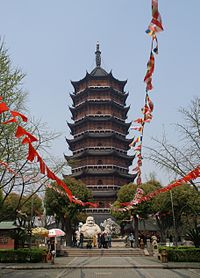Beisi Pagoda: Difference between revisions
| Line 3: | Line 3: | ||
==History== |
==History== |
||
Although the present structure dates to the [[12th century]] (with [[renovation]]s in following eras), the historical site of construction for the [[pagoda]]s dates back 1,700 years. A [[Buddhist]] pagoda built during the reign of [[Sun Quan]] in the 3rd century originally stood at the site (in honor of his [[wet nurse]]), along with another pagoda built during the [[Liang Dynasty]] (502-557). The current pagoda structure was built between the years 1131 and 1162, during the [[Song Dynasty]] (960-1279). Patronage and construction for the Song era pagoda was headed by the Buddhist [[monk]] Dayuan. During the modern repairs of the pagoda in 1960 and 1975, Chinese artifacts were found within the [[steeple (architecture)|steeple]], including a copper turtle and statues of the [[Buddha]]. |
Although the present structure dates to the [[12th century]] (with [[renovation]]s in following eras), the historical site of construction for the [[pagoda]]s dates back 1,700 years. A [[Buddhist]] pagoda built during the reign of [[Sun Quan]] in the 3rd century originally stood at the site (in honor of his [[wet nurse]]), along with another pagoda built during the [[Liang Dynasty]] (502-557). The current pagoda structure was built between the years 1131 and 1162, during the [[Song Dynasty]] (960-1279). Patronage and construction for the Song era pagoda was headed by the Buddhist [[monk]] Dayuan. During the modern repairs of the pagoda in 1960 and 1975, Chinese artifacts were found within the [[steeple (architecture)|steeple]], including a [[copper]] [[turtle]] and statues of the [[Buddha]]. |
||
==See also== |
==See also== |
||
Revision as of 12:44, 28 July 2007

The Beisi Pagoda (Chinese: 北寺塔; pinyin: Běisì Tǎ; Wade–Giles: Peiszu T'a) or North Temple Pagoda is a Chinese pagoda located at Bao'en Temple in Suzhou, Jiangsu Province, China. The base of the pagoda has an octagonal frame, and the tower rises nine stories in a total height of 76 m (243 ft). The pagoda was once eleven stories tall, yet was damaged and reduced to nine stories. It's double eaves and flying corners are similar to that of the Liuhe Pagoda found in Hangzhou, another 12th century Chinese pagoda. Its base and outside walls are made of brick, the balustrades made of stone, and the eaves and banisters encircling the structure are made of wood.
History
Although the present structure dates to the 12th century (with renovations in following eras), the historical site of construction for the pagodas dates back 1,700 years. A Buddhist pagoda built during the reign of Sun Quan in the 3rd century originally stood at the site (in honor of his wet nurse), along with another pagoda built during the Liang Dynasty (502-557). The current pagoda structure was built between the years 1131 and 1162, during the Song Dynasty (960-1279). Patronage and construction for the Song era pagoda was headed by the Buddhist monk Dayuan. During the modern repairs of the pagoda in 1960 and 1975, Chinese artifacts were found within the steeple, including a copper turtle and statues of the Buddha.
